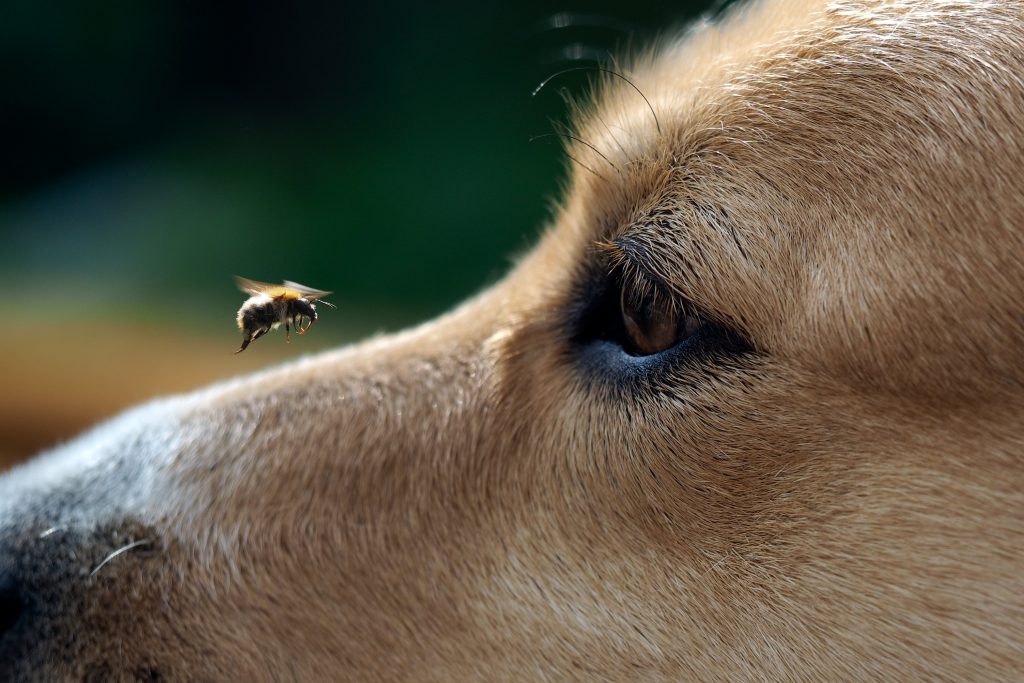With the onset of spring comes flowers, and with those come bees. Chances are you’ve seen hilarious photos of a dog stung by a bee with cartoonishly swollen noses. But much as we love nature’s pollinators, a bee sting can be dangerous to humans and dogs. Just like humans, our dogs can have deadly allergies to a sting.
So what do we do if a bee stings our dogs, and how do we know if it’s serious?
 How To Tell If Your Dog Got Stung By A Bee
How To Tell If Your Dog Got Stung By A Bee
We first need to know how to recognise a bee stung. This is no problem if your dog was chasing a bee and you saw them swallow one, but if you didn’t see the sting, you need to identify it. A dog can have four basic types of responses to bee stings:
Signs of a mild local reaction to a bee-sting
This is a simple reaction to a bee sting in dogs that are not allergic. You may see
- Possible mild signs of distress such as whining, panting, or lip licking
- Showing signs of pain or irritation, such as limping or holding up a paw if they stepped on the bee
- Swelling and heat in one area called the wheal and flare.
- Nibbling or pawing at a particular area
- A pustule
- Itchiness
Signs of a regional reaction to a bee sting
This is a mild allergic response that you need to keep a close eye on.
- The dog may look more visibly distressed, such as crying, rapid panting or restless.
- Redness and inflammation
- Excessive swelling and or hives
- Hardness around the sting site
- Extreme itchiness
Signs of a severe allergic reaction after a bee sting
The following are signs that your dog needs to go to the vet immediately:
- Vomiting.
- Diarrhoea.
- Hives
- Breathing extremely fast or extremely slow
- Coughing or wheezing
- Runny discharge from nose and eyes
- Very fast or very slow heart rate
- Extremely swollen head or muzzle
- Excessive drooling
- Blue gums and tongue
- Excessive itching
- Wheals or swelling red skin
In rare cases, the fourth kind of allergic reaction can happen. This delayed anaphylactic shock can occur up to two weeks after the sting.
Some breeds, specifically Bull Terriers, Boxers, and Staffordshire Terriers, seem more prone to bad reactions to bee stings, so pet parents of these dogs should take extra caution.
What Do You Do If Your Dog Gets Stung By A Bee?
The most important thing to do if your dog has a bee sting is to stay calm and follow these steps:
- Try to find the site of the bee sting to remove the stinger.
- Do not use tweezers or your fingers to remove the stinger. Squeezing can force more venom into your dog’s skin.
- Instead, take a credit card or something flat, thin, and hard to gently leverage the stinger out of the skin. Lift it up from below the poison sac.
- Apply ice to the site.
- Monitor your dog for at least 30 minutes for any signs of an allergic reaction (but read our additional information below on the possibility of delayed reactions and which breeds are more at risk)
- If your dog swallowed a bee, look for signs of swelling blocking their airway and be prepared to open it if you need to.
You can call your vet and ask about giving your dog a human antihistamine. Common advice is to give a dog Benedryl for allergies, which sometimes works for canine swelling and hives. However, human antihistamines are often quite ineffective on dogs.
In one study, only 18% of dogs responded to Cetirizine, one of the more effective human antihistamines. Furthermore, OTC human antihistamines often have added compounds, such as decongestants, that are dangerous for dogs.
A better idea than to rely on human antihistamines is to speak to your vet and ask about potentially getting a prescription for canine antihistamines to keep in your dog’s emergency kit. If you suspect your dog has an allergic reaction, place a pill under its tongue and try to keep it there while it dissolves.
An online pharmacy such as Pet Chemist can help you save up to 50% on these kinds of medications if your vet authorises it.
Will My Dog Be Okay After A Bee Sting?
Your dog should be fine after a bee sting but it is important to keep an eye on them in case they are allergic. In non-allergic dogs, the red swelling (wheal & flare) will disappear in 30 to 60 minutes. It may then form a pustule within 24 hours that can last up to 3 weeks and be very itchy.
Try to stop your dog from scratching the bee sting, as breaking the skin can cause a secondary infection. Speak to your vet about a topical ointment for itchiness if this is a problem.
Essential facts every dog owner should know about bee stings
If your dog has a severe reaction to a bee sting, it may be worse the next time. Dogs that have previously been stung or stung by multiple bees are more prone to an allergic reaction. Multiple stings are particularly dangerous.
Being stung by more than 20 bees is lethal for most mammals. So it’s best to ask your vet for a prescription for effective canine antihistamines to keep close to your pet emergency essentials. Also, be aware of your dog’s environment to avoid bees wherever you can.
It’s essential to monitor your dog for at least 30 minutes after a bee sting to check for signs of an allergic reaction. Severely allergic dogs will usually show signs of anaphylaxis within 10 minutes after the sting.
However, there is such as thing as delayed hypersensitivity reactions that can occur three days to 2 weeks after the sting. These cases may be quite severe, so if you have a breed more prone to bee sting allergies, keep a closer eye on them.
If your dog does show signs of anaphylactic shock from a sting, stay calm and get to your emergency centre quickly. The important thing to remember is that even dogs with severe anaphylaxis have an 85% survival rate, provided they get medical treatment.
Final Thoughts
Bees are a vital part of our ecosystem, but that doesn’t mean they can’t be hazardous to our pets. As pet parents, it’s good practice to know what to do if our dogs are stung by bees, wasps or other insects and to recognise the signs of an allergic reaction. Being prepared for an emergency and ready to act fast when needed is all part of being the humans our canine companions need.



1 comment
Thank you , very informative.